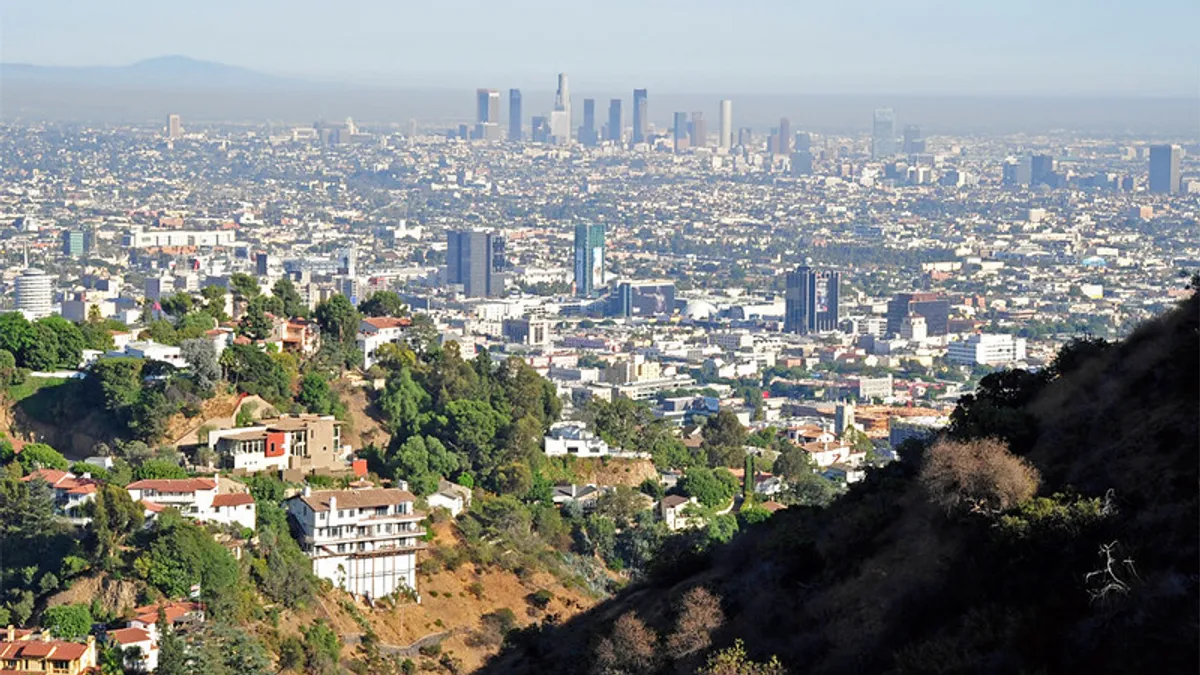Dive Brief:
- The City of Los Angeles, alongside the LA Department of Transportation (LADOT) and the city's Urban Movement Labs (UML), announced Wednesday the Urban Air Mobility Partnership, an effort to make the city a leader in urban air mobility (UAM).
- The initiative will educate and engage residents on urban air vehicles, including through a demonstration vertiport where people can explore a prototype flying car. The one-year partnership will also design a policy toolkit for other governments to use in preparing their skies for the vehicles, and will help Los Angeles map out technological challenges and potential solutions surrounding public airspace and property rights.
- On a webinar hosted by the National League of Cities (NLC), LADOT General Manager Seleta Reynolds said the partnership is designed to ensure city planners do not repeat the mistakes of the past when it comes to land-use planning, which have resulted in cars taking prevalence over other modes, increased congestion and inequity.
Dive Insight:
The partnership builds on a framework released in September by the city and the World Economic Forum (WEF), which looked to support UAM including electric vertical take-off and landing (eVTOL) aircrafts — known informally as "flying cars". Those principles include noise mitigation, safety, equity and connections to existing transportation options.
Los Angeles is now positioning itself as a leader in UAM technology, having been selected by Uber as one of the first for its Uber Air service, and with architects showing off designs for so-called "skyports" at the Uber Elevate summit last year. Uber sold its Elevate arm to Joby Aviation earlier this month and invested $75 million in the company, with the two entities promising to integrate their services into each other’s apps.
During the NLC webinar, Reynolds said the time is now for cities to start planning how they will use their airspace, especially as drone deliveries and flying cars have moved beyond a technologists’ pipe dreams to a close reality.
"As we think about the public space on the ground, those streets and those sidewalks, it's now time for us to think in three or four dimensions and consider public space over our heads... How is this change going to enable cities to solve some of these challenges that we're dealing with on the ground, and how can we make sure that we do not repeat some of the same mistakes that our foremothers and forefathers made when they laid out the ground transportation system," Reynolds said.
To avoid those mistakes, Reynolds said the planning process needs to start as soon as possible, especially when involving so many government agencies including the Federal Aviation Administration (FAA) and NASA. In recent years, cities have been on the back foot when it comes to planning for innovations like ride-hailing and dockless mobility, and Reynolds said that must be avoided.
Already, UML has been a key part of that planning process since its launch last year. In November, it unveiled a flagship Transportation Technology Innovation Zone in the West San Fernando Valley so private companies and innovators can test tech-driven transportation solutions.
"Typically, when we're behind the eight-ball, when we're reacting, when we're in that defensive posture, that's when maybe we don't do our best work and where we have to skip or short-cut important parts of the process," Reynolds said.
Part of that process will be around community engagement and education, which can help demystify the technology and at the same time help formulate policies to help integrate UAVs. The demonstration vertiport, Reynolds said, could be a key way to help grow residents’ understanding of the technology, which can feel very abstract at times.
"Right now, when you go into communities and you want to talk to them about something like this, first of all it seems very 'Jetsons' and very far off into the future,” Reynolds said. "People have a lot more pressing worries that they need from city government right now. And second, it's difficult for them to envision the kinds of things they might care about."
There will also be national-level steps taken to prepare cities and towns for the onset of UAM. During the webinar, NLC announced it will form an Unmanned Air Mobility Integration Advisory Forum, made up of representatives of cities and towns who will advise the federal government on how to integrate aerial vehicles into the country’s airspace.
Fort Collins, CO Mayor Wade Troxell, who serves on NLC's Transportation and Infrastructure Services Committee and the Federal Aviation Administration’s (FAA) Drone Advisory Committee, said during the webinar the 25-member working group will provide "strategic advice to a range of government and industry actors" who are advancing the technology, and "ensure there is substantial coordination among all levels of government." It will provide insight on areas like federal rule making, operations and traffic management, Troxell said.












